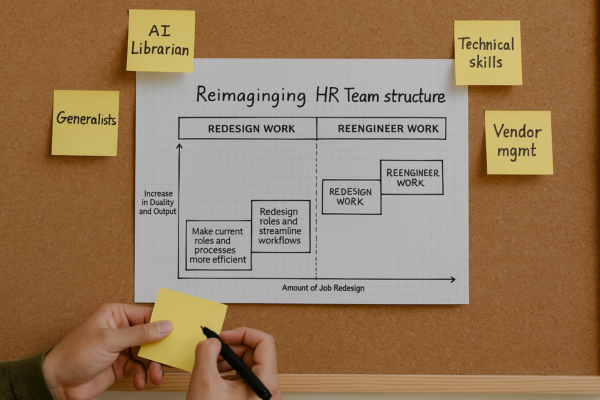Recently, I asked ChatGPT what the hot new tech jobs were back in 2014 and its top response was Data Scientist. I remember when data science first became a buzzword—this seemingly magical blend of statistical expertise, proficiency with SQL, and the rare ability to distill complex data into accessible insights. As organizations were wrapping their heads around data science, “big data” was emerging, bringing with it a realization that companies needed to control and understand the vast amounts of data flowing through their systems. Companies like Snowflake and Splunk skyrocketed to multi-billion dollar prominence during this era.
Fast forward a decade and we find ourselves in a similar cycle—but this time, it’s about unstructured data sitting inside all those documents we deal with on a daily basis. AI is unlocking incredible value and operational efficiencies from the terabytes of text, documents, policies, procedures, presentations and other content that, until recently, sat buried and unsearchable within organizations. This surge has fueled the rise of AI-powered products like Winslow for HR and Sierra for customer support. Is there an equivalent job to Data Scientist we should expect to see? Yes, it’s an AI Librarian and some companies already have them in place. What Does an AI Librarian Do?
What is an AI Librarian and What Do They Do?
At Winslow, we think a lot about the challenges and opportunities that organizing policies and procedures pose for HR teams. Then we came across this insightful post about AI librarians and realized it’s a broader issue than just in HR. As unstructured data grows more valuable—and mission-critical to AI-powered organizations—a human presence is going to be required to curate, clean, and ensure the accuracy, compliance, and consistency of this data.
The AI Librarian plays a pivotal role in maximizing the value and integrity of an organization’s unstructured documents. Here are their primary responsibilities:
Curating and Organizing Data: AI Librarians ensure that documents are appropriately categorized, tagged, and made accessible for AI tools and human users alike. This includes creating clear taxonomies and metadata frameworks that help AI and humans alike make sure they are working with the right information. Winslow has a complete feature set designed to help HR teams categorize documents into “personas” so that every employee gets served the right answers to their questions.
Ensuring Data Accuracy and Consistency: AI Libraries regularly review and audit content for accuracy, removing outdated or erroneous data and ensuring consistency across all information sources. A bevy of AI-powered products will emerge to make this an efficient process as it’s nearly impossible for a human or team of humans to do right now.
Compliance Management: With ever-changing regulations, the AI Librarian maintains a watchful eye on content to ensure it meets legal and regulatory standards, minimizing the risk of compliance breaches. This is especially true in HR.
Data Integration and Change Management: They work to integrate new data sources seamlessly while managing changes to existing content, ensuring updates are accurately reflected in all relevant systems.
Facilitating AI Training: For the increasing number of AI products inside an organization, AI Librarians are critical to providing clean, relevant, and well-structured data for them. AI Librarians play a crucial role in training or enabling AI models, ensuring the quality of AI-driven insights and decision-making.
Collaboration Across Departments: AI Librarians liaise with various teams (e.g., HR, legal, IT) to understand data needs, address gaps, and implement governance policies effectively.
Gatekeeping New Content: They serve as gatekeepers, reviewing new content submissions for quality, relevance, and compliance before they become part of the organization’s knowledge base.
Historically, HR teams might have only addressed this issue with limited effort given how herculean the task can be. Many teams are aware that some of their policies likely need updates, might conflict with each other, or may contain compliance gaps. In addition, the pace of federal, state, and local regulatory changes continues to accelerate, challenging even the most attentive teams. To make matters worse, the incredible promise of tools like ChatGPT to make content creation easier than ever will put an increasing demand on content libraries to review, cross-reference and vet new content for compliance.
This all sounds like a full time job. Enter the AI Librarian: a role designed to establish guardrails around a company’s content, serving as both gatekeeper and steward of accuracy and compliance.
How to Prepare Before Your AI Librarian Arrives
However, hiring a dedicated AI Librarian for every function—let alone HR—isn’t feasible for most organizations. Here are some practical steps to prepare your HR team for a future of AI-driven products which will massively improve operational efficiency. Small efforts up front in managing your policy knowledge base will pay huge dividends once you adopt AI technology.
Conduct a Content Inventory
Identify all the policies and procedures governing how your HR team and broader organization operate. In our conversations with Winslow users, we often discover content scattered across multiple sources.
Establish a Single Source of Truth
Do you have a single, definitive location for your HR policies and procedures? Many organizations copy documents from one platform (e.g., SharePoint) to another (e.g., an HRIS system), introducing errors and risking outdated content reaching employees. This may require some change to where your team or employees go to get their information.
Integrate Document Management with Policy Sign-Off Processes
Ensure that your document change management processes align with policy acknowledgment workflows. If employees are required to sign off on updated policies, your knowledge base should be tightly integrated with this process.
Track Policy Changes Effectively
When a new policy is required or an existing one needs revision, how is this tracked? Project management tools like Jira, Trello, or Asana can greatly simplify this process for both small and large teams.
Categorize and Contextualize Documents Clearly
Different employees may require different sets of documents depending on their location, role, or classification. For example, regulations may vary by state or country, and union members may have unique terms due to collective bargaining agreements. Your document management strategy should accommodate these distinctions. It’s not practical to have all this information held in your HR team’s head anymore. You’ll need to write it down so an AI product can understand it.
As AI becomes increasingly embedded within your organization’s tools and workflows, addressing these foundational questions is critical. As your organization scales, other departments will likely face similar challenges. Eventually, someone may propose a dedicated role to manage and curate your content—just as organizations have with data. The good news is you’ll already know the answer: the AI Librarian.



